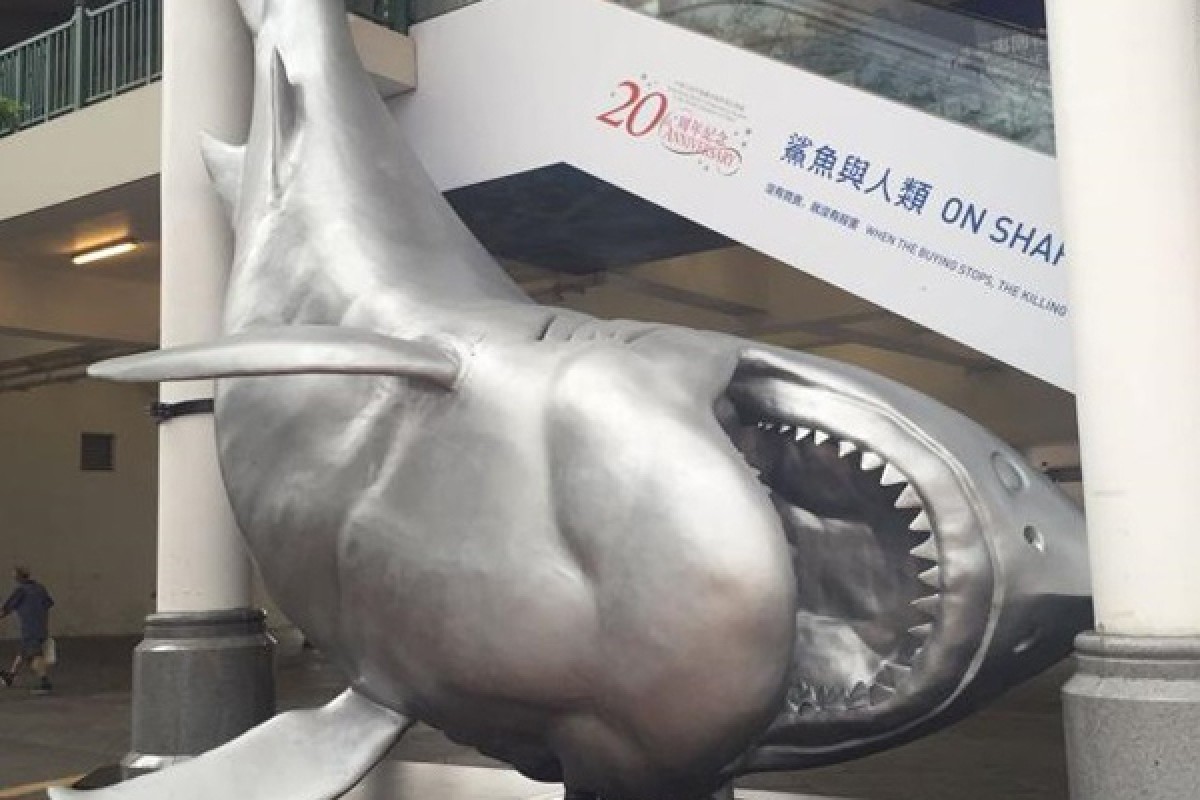
Cruelty of shark finning on full display at Hong Kong Maritime Museum
Shark finning is wrong – you know that. But what about those who refuse to acknowledge how damaging this practice is? That’s what a new exhibition on sharks hopes to change
 The exhibition will run until the end of summer – there’s plenty of time left to go and see it with your family!
The exhibition will run until the end of summer – there’s plenty of time left to go and see it with your family! No Chinese wedding is complete without a round of shark fin soup – or so Chinese tradition dictates. Hong Kong remains one of the biggest consumers of this traditional Chinese dish, despite the cruelty, and the damage it does to our marine ecosystem. A new exhibition at the Maritime Museum in Central is looking to challenge the assumptions of Hongkongers that we need shark’s fin soup.
Young Post took a look around, and sat down with Libby Chan, the senior curator behind On Sharks and Humanity, and local artist Peggy Chan for a chat.
This is the first time any exhibition of this kind has been introduced to Hong Kong, but the exhibition, sponsored by Hong Kong Parkview and WildAid, has previously appeared in four other cities. In order to raise public awareness of the important role sharks play in the marine ecosystem, artists from around the world have helped to create 36 shark-hunting inspired artworks.
“Around 14 to 16 per cent of the shark fin trade in Asia is done in Hong Kong,” said Chan. “Hong Kong is such a commercial city that, [when you look at] the rise in demand of dried seafood, the shark fin trade isn’t likely to end any time soon.
“Shark fin is symbolic of being rich in Chinese culture, and a host is expected to make an effort to prepare shark fin for their guests.” She added that there isn’t a law to stop fishermen from shark finning, so fishermen continue to take part in this practice because they’re simply supplying a demand. “We wanted to create an interactive and lively platform that’s educational, inspiring and reflective for visitors.”
The exhibition is all of that and more – with the artwork varying from sculptures, to oil paintings, and from interactive art to poems. The exhibition spills out from the museum onto Central Pier, and commands the attention of passers-by.
“The exhibition allows people of all ages to take in the art and [helps them to] think from the shark’s perspective.” What does Libby want visitors to take away from their time at the exhibition? “[To realise] the reality of what sharks are put though. When the buying stops, the killing will stop too.” Libby recalled the story of a retired fisherman who previewed the exhibition before it opened to the public. “He was very upset when he saw a painting of a shark being thrown into the water after its fins were cut off. There was a lot of remorse and empathy in his eyes.” That oil painting is still in the exhibition.
Libby’s favourite pieces from the exhibition are It is neither a food nor a snack II and Net. The first piece depicts a young student sucking on a shark-shaped ice lolly, and is symbolic of how, like the girl, we don’t bother thinking about why we eat shark fin. We just do. The second is, quite literally, a foreboding net that’s strung out across the ceiling. This puts the people who view the exhibition in the position of the unsuspecting sharks that get killed for their fins.
Libby acknowledged that there are many young people who are aware of the cruelty of this practice, and that it can be hard to uphold that desire to remain environmentally responsible in the face of tradition and your parents. But there are ways, she said, of taking a stand. “Be polite and have all the facts when you talk about why you don’t want to eat shark fin. Do your research and collect statistics. Explain what supply and demand is – and bring them to the Maritime Museum to learn more about the shark fin trade.”
One of the artists with work being displayed in the exhibition is Peggy, who is describes herself as an advocate of protecting the environment. She believes that humans and nature are connected, and has explored the relationship between a person, the city and nature in her work The Shore Beyond. It’s a kaleidoscopic light display that uses imagery of humans, sharks and the ocean, created using the Cyanotype technique – a photographic printing process that produces a cyan-blue print. Spinning the interactive installion around sets in motion the display on the wall, which weaves together all three elements.
Peggy said she feels very lucky to be able to take part in an internationally acclaimed exhibition on her home turf, and it’s in the name of raising public awareness of the declining numbers of wild sharks. Thanks to Parkview Arts Action and the Maritime Museum, she has also been conducting family art workshops to help educate and inspire others to campaign for the end of shark finning. She has another art series, Peggy added, that will be on nature conservation and shark protection. This will go on display at the Macao Museum of Art in Macau.
Although shark finning is, like Peggy says, a normalised part of almost every Hongkonger’s life, that doesn’t mean we should be content to let it carry on. Thanks to exhibitions like the one currently running at the maritime museum, we can encourage others to do their part in changing a way of thinking that belongs in our past. It’s time to realise that sharks are friends, not food.
On Sharks and Humanity is open now, and will run until the end of September.